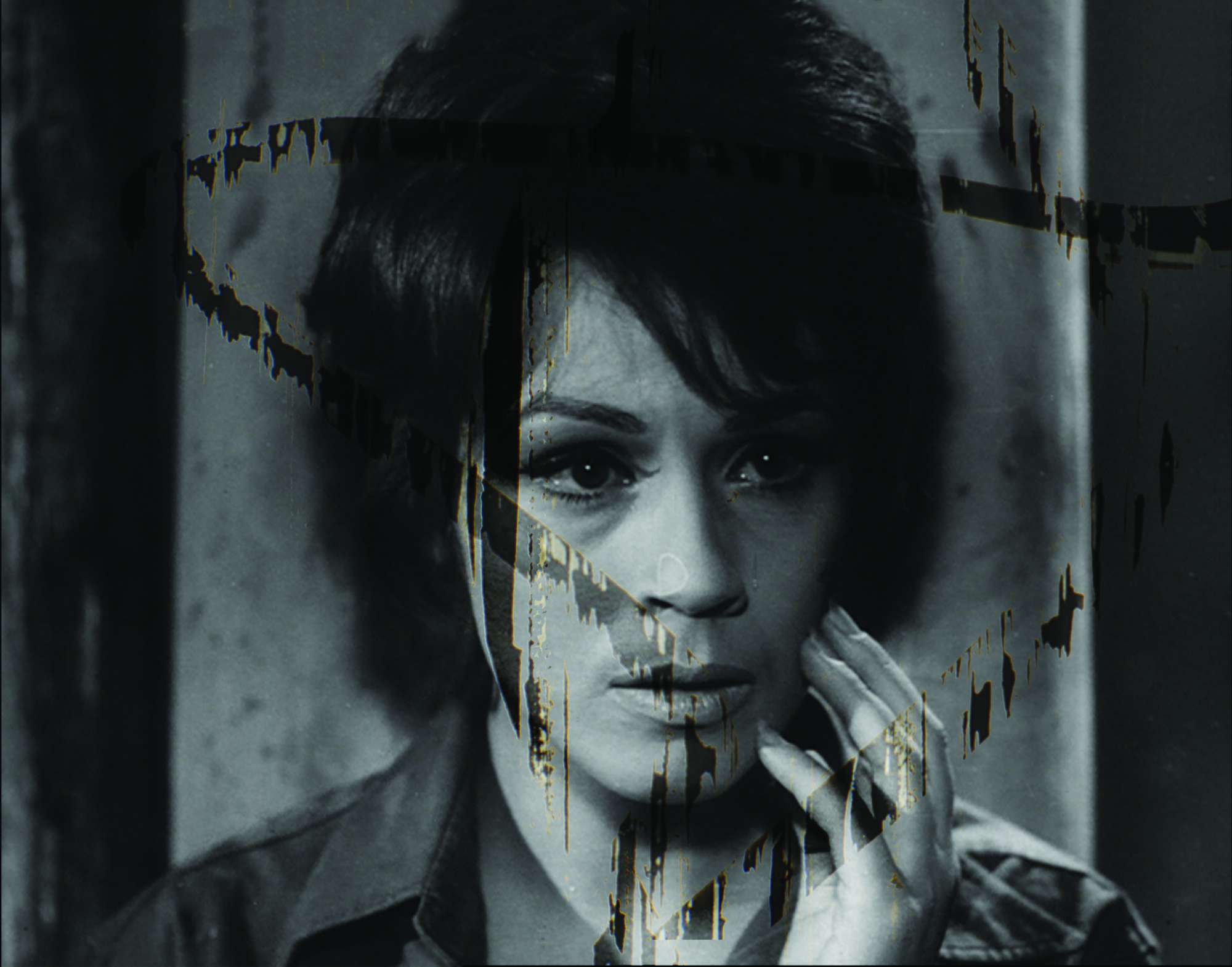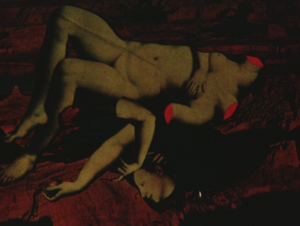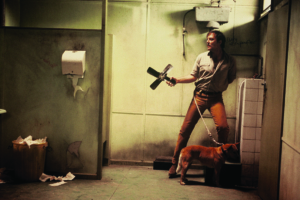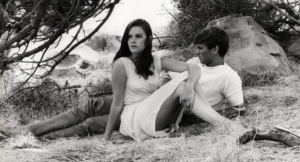On the eve of its premiere in March, video-art work Terror Nullius (2018) – by the duo Soda_Jerk, Sydney-born sisters Dan and Dominique Angeloro – was disowned by one of its funding bodies. The Ian Potter Cultural Trust, which gave A$100,000 for the making of the film, distanced itself from the finished product, describing it as ‘a very controversial piece of art’ and ‘un-Australian’.[1]Luke Buckmaster, ‘Terror Nullius: “Controversial” Australian Film Loses Funders’ Support’, The Guardian, 19 March 2018, <https://www.theguardian.com/film/2018/mar/19/terror-nullius-controversial-australian-film-loses-funders-support>, accessed 20 July 2018. There’s some irony in this, given that Terror Nullius explores Australian cultural identity, as expressed through Australian cinematic identity. The Angeloros, in an interview with me, call themselves ‘deep nerds for Australian cinema’, and cite films like Bad Boy Bubby (Rolf de Heer, 1993) and Tracey Moffatt’s Nice Coloured Girls (1987) and Night Cries: A Rural Tragedy (1990) as formative inspirations. Comprising a voluminous array of samples – spliced together after an ‘incredibly labour-intensive’ eighteen months of frame-by-frame rotoscoping – their ‘political revenge fable in three acts’ is a satirical mashup of Australian cinema and iconography: a feminist, queer upending of what has been, largely, a blokey cinematic mythology. ‘If being un-Australian means calling bullshit on a lot of the really ugly things that pass in our current political climate, then we’ll happily wear it,’ the duo offer. ‘But, for us, Terror Nullius is not about the nihilistic annihilation of national identity; it’s a project that is deeply invested in trying to rethink what being Australian could mean.’
In digging into Australian cinematic history, the duo examine – and often subvert – the stories that have already been told. In re-contextualising these images, they’re also evoking the shadow history of films unmade: the stories that haven’t been told, and the people who haven’t been able to tell them. This is something that Terror Nullius shares with Sari Braithwaite’s documentary [Censored], which screened alongside it at this year’s Sydney Film Festival (SFF). Braithwaite’s work is likewise assembled entirely from Australia’s cinematic past: an essay-movie fashioned from scraps of censored celluloid cut from films by the Commonwealth Film Censorship Board from 1958 to 1971.[2]Arenamedia, [Censored] press kit, 2018, p. 3. In cataloguing the images deemed too risqué for old-timey audiences, Braithwaite, too, couldn’t help but notice which stories were being told – and which weren’t. Only one of the nearly 2000 clips censored during all those years, for instance, was from a film made by a woman: Agnès Varda’s Le Bonheur (1965).

Archive fever: [Censored]
While researching Smut Hounds (2014), her short film about David Stratton’s battles with the censors as SFF director in the 1960s, Braithwaite discovered buried reels of film in the National Archives of Australia (NAA): offcuts from fourteen years of censorship, catalogued, very roughly, in alphabetical order by film title.
Prior to 1971, Australian cinema-goers were sheltered from on-screen depictions of sex and violence by a secret government body that, during a time of film-print scarcity, could control distribution. ‘An imported film shall require cuts if it is likely to be offensive to the people of a friendly nation,’ reads an intertitle in [Censored], cribbed from a Censorship Board bulletin. ‘The Board,’ states another, ‘does not deny adult Australians the opportunity to see films which examine the various social problems of contemporary life, provided that they are presented in a manner that is not obscene.’
Braithwaite got full access to the archives a year-and-a-half after her discovery, then spent two years undertaking archival research. This meant poring over VHS and DigiBeta copies of the original reels in dark rooms at both the NAA’s storage facility in Sydney and the Public Record Office Victoria in Melbourne. The materials amounted to 1991 clippings, ranging from high-art new-wave cinema to trashy exploitation, the scenes cut and gathered completely out of context. Her job, she recounts, was to fashion ‘these stray fragments, these displaced frames’ into a singular, coherent work.
Braithwaite’s journey into the archive’s heart of darkness provides [Censored]’s narrative arc … like her, viewers might arrive expecting a fun time redressing backwards, postwar puritanism, only to be forced to wrestle with the spectre of the patriarchy.
‘When I began,’ Braithwaite offers in her narration at the film’s beginning, ‘I imagined I would liberate these films, liberate us from the tyranny of censorship.’ She daydreamed of living her own Cinema Paradiso (Giuseppe Tornatore, 1988), heroically unleashing the romantic power of film by throwing off the yoke of suppression. But, over time – and conveyed across [Censored]’s sixty-three-minute running time – Braithwaite found herself grappling with the archive, even coming to loathe it. ‘It was a very difficult film to make, to keep the momentum going,’ she says. That difficulty became the text of [Censored] itself, which grapples not just with censorship, but with cinema history.
While there are excised scenes shown in whole – from classic films like Persona (Ingmar Bergman, 1966), Repulsion (Roman Polanski, 1965), Masculin Féminin (Jean-Luc Godard, 1966), Bob Dylan: Don’t Look Back (DA Pennebaker, 1967) – out of respect to their artistry, a great deal of these off-cuts show little such artistry, and were problematic unto themselves. Sex and violence were the main things the Censorship Board was ‘protecting’ viewers from – ‘Themes dealing with the sordid side of life are the basis of an ever-increasing proportion of films,’ it lamented, in another quoted intertitle – so Braithwaite found herself sitting through endless examples of violence and rape, the few women on screen subjected not just to the male gaze, but to toxic masculinity. The romantic thrill of liberation waning, Braithwaite dealt with a growing, inexorable sense of revulsion at what she was seeing. ‘[I]n creating this archive, what the censors accidentally created was a distilled catalogue of the destructive patriarchal imaginary,’ Braithwaite has written.[3]Sari Braithwaite, ‘[Censored] Was Meant to Celebrate Freedom. Instead It Exposes Something Darker’, The Guardian, 31 May 2018, <https://www.theguardian.com/film/2018/may/30/censored-was-meant-to-celebrate-freedom-instead-it-exposes-something-darker>, accessed 20 July 2018. Or as she puts it, with comic horror, in her narration: ‘I was liberating a state-sanctioned spank bank.’
In [Censored], these random offcuts are gathered into thematic montages. The first, called (in the end credits) ‘Kissing’, does indeed evoke Cinema Paradiso. From there, they get progressively darker: ‘Little Man, with His Little Knife’ is full of leather-jacketed thugs, brandishing blades and broken bottles; ‘Hold a Man’, good old-fashioned fistfights and bar-room brawls; and ‘Death Offers No Resolution’, endless very theatrical, sometimes gruesome deaths. ‘Hit a Girl’ is a showreel of men slapping women, glamorous dames put back in their place when they get too mouthy; this old trope is horrifying now, especially – as in The Night of the Following Day (Hubert Cornfield, 1969) – when violence is conflated with passion. Speaking of which: ‘You’re Going to Thank Me When It’s All Over’ is made from scenes of men kissing women even as they try to resist, this struggle routinely depicted as a form of foreplay. From there, this montage moves to depictions of rape, which often look less like female nightmare, more like male fantasy. ‘Peeping Tom’ gathers together randy voyeurs, camera and character both leering with the male gaze, and ‘Strip Strip Strip’ is a variation on that theme, whereby striptease sequences come replete with braying male audiences entering into a collective frenzy. The film’s final montage, ‘The Spectator’, consists of images of crowds, onlookers, spectators – those who, watching taboo acts, serve as on-screen avatars for the cinema audience. This illustrates [Censored]’s theme of collusion, a visual manifestation of Braithwaite’s unease about having been made a collaborator, a liberator, of troubling images.
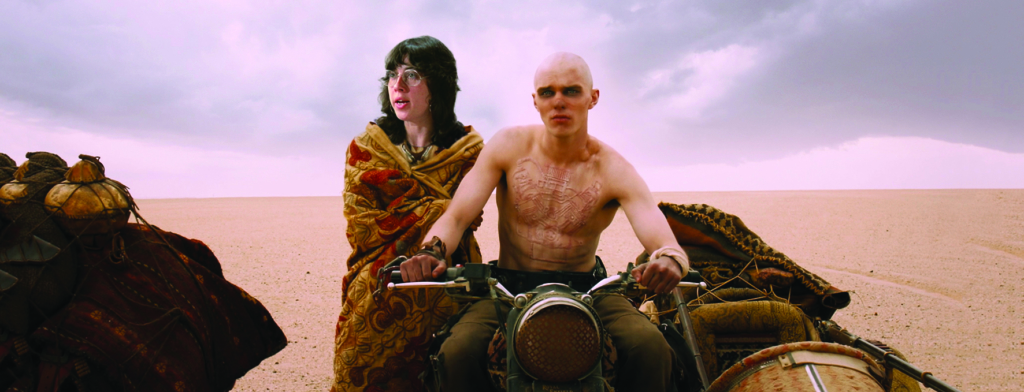
‘I wanted to hang with that really uncomfortable idea of repetition,’ Braithwaite says, of this device, which echoes her own experiences of having seen these acts over and over. This realisation raised difficult questions about what kind of film she was making, and why she was making it. Braithwaite shares this aloud in voiceover, her narration full of moral and personal dilemmas: ‘I revived these hidden relics and, in doing so, I became complicit in problems I could not solve, and in questions I still could not answer.’ Braithwaite admits she was ‘a very reluctant narrator’, this hesitation springing, in part, from the film’s change in on-screen identity from the historical to the personal. Braithwaite’s journey into the archive’s heart of darkness provides [Censored]’s narrative arc, a way of giving shape to the mosaic. ‘It would be something for the audience to latch onto,’ she reasons, especially given that, like her, viewers might arrive expecting a fun time redressing backwards, postwar puritanism, only to be forced to wrestle with the spectre of the patriarchy.
By conclusion, Braithwaite realises that she, too, is a kind of censor: choosing what footage does and doesn’t make it into her film, and the context in which it’s presented. ‘Both filmmaking and censoring are expressions of power,’ she offers, in narration. ‘Both dictate what is seen.’ In turn, her thoughts on censorship have only grown more nuanced, Braithwaite now holding ‘a number of seemingly contradictory or conflicting ideas true at the same time’ – aware that the issue isn’t black-and-white, lines always having to be drawn somewhere. ‘We need to have a much more complicated idea of what this powerful force in our culture continues to be,’ she offers. ‘It’s useless to say you’re “for” or “against” censorship. Censorship just is. Our job is now to work out what happens when certain funnels of information are closed off.’
Mad mashup: Terror Nullius
Soda_Jerk are also ‘interested in the politics of images: how they circulate, whom they benefit, and how they can be undone’.[4]‘About’, Soda_Jerk official website, <https://www.sodajerk.com.au/about.php>, accessed 20 July 2018. The siblings saw [Censored] at its SFF premiere, admiring the ‘form and ambition’ of Braithwaite’s film and the subjects it stirs up. ‘We certainly feel that these kinds of discussions around the ethics of image control are urgent and timely,’ they offer. But the duo’s own ‘politics and ethics’, as well as their filmmaking style, are radically different. The Angeloros operate with a belief in the wide-open exchange of imagery and ideas, proselytising the virtues of ‘free culture activism’.[5]Soda_Jerk, quoted in Meg Crawford, ‘How Soda_Jerk Created The Avalanches’ Viral Mega-mashup’, Red Bull website, 16 February 2018, <https://www.redbull.com/au-en/avalanches-mega-video-mash-up-soda-jerk>, accessed 20 July 2018.
Though Terror Nullius digs through Australia’s cinematic history, its character doesn’t speak to academia, but to ‘the internets’. In their provocative mashups and culture-jamming collisions of high- and lowbrow imagery, Soda_Jerk’s work mirrors the anarchic, lurid qualities of memedom.
Working ‘exclusively with samples’, Soda_Jerk ‘think of [their] filmmaking as a kind of rogue archival practice’. But, though Terror Nullius digs through Australia’s cinematic history, its character doesn’t speak to academia, but to ‘the internets’.[6]Soda_Jerk, quoted in Briony Wright, ‘Soda Jerk Remix Cinema History to Create the Best Movies That Never Existed’, i-D, 10 January 2017, <https://i-d.vice.com/en_au/article/gyqeb9/soda-jerk-remix-cinema-history-to-create-the-best-movies-that-never-existed>, accessed 20 July 2018. In their provocative mashups and culture-jamming collisions of high- and lowbrow imagery, Soda_Jerk’s work mirrors the anarchic, lurid qualities of memedom; Terror Nullius’s archival recontextualising comes closer to ‘Steamed Hams’[7]A skit from the Simpsons episode ‘22 Short Films About Springfield’ (Season 7, Episode 21), which has now gained infamy in meme form. than Thom Andersen (an inserted shot of Toni Collette in Sue Brooks’ 2003 Japanese Story is played exactly like a reaction GIF). Memes, the duo offer, articulate a ‘combustion of cultural boundaries’,[8]Soda_Jerk, quoted in Bailey Sharp & Ben Juers, ‘“Weaponising Frustration and Despair” – an Interview with Soda_Jerk’, The Lifted Brow, 26 March 2018, <https://www.theliftedbrow.com/liftedbrow/2018/3/25/weaponising-frustration-and-despair-an-interview-with-sodajerk>, accessed 20 July 2018. reflecting a consumable culture in which everything – news, politics, social media, entertainment, debate – has become indivisible in the internet’s all-consuming, singular ‘feed’.
In turn, Terror Nullius opens – after a fanfare that sounds out ‘Advance Australia Fair’ in deflating air-horn sound effects – with a deliberate muddying, if not mocking, of the notions of traditional form. ‘This program is a drama, not a documentary,’ reads an introductory intertitle. ‘Some events in this program have been fictionalised for dramatic purposes. Gina Rinehart was not interviewed for this program.’ This evocation of Rinehart establishes the openly political tenor of the film, which makes targets of all the totemic figures of Australia’s far right: Reclaim Australia racists, ‘Angry’ Anderson, John Laws, John Howard, Tony Abbott, Pauline Hanson. The last of these meets her on-screen demise via a thrown boomerang, as part of the film’s narrative of a bloody uprising against conservatives, colonialism and the swinging-dick heroes of cinematic yore. Righteous vengeance is the oldest trope in the screenwriting book, and, here, it’s employed as a manifestation of long-simmering rage, with historically marginalised figures – women, queers, Indigenous Australians, animals, the environment – enacting their gleeful revenge.
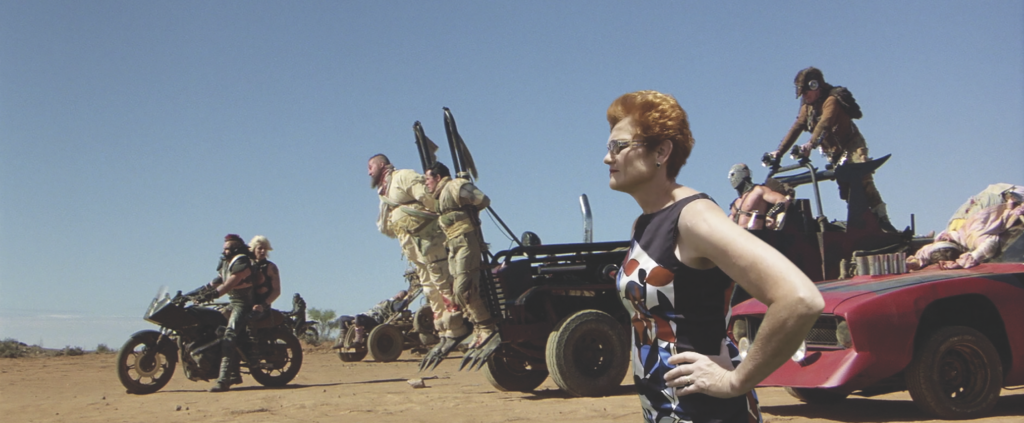
In the world of Terror Nullius, Australia is a sunburnt country of horrors environmental, colonial and contemporary. When the asylum seekers from Lucky Miles (Michael James Rowland, 2007) land on our beaches, they’re now met by Russell Crowe in Romper Stomper (Geoffrey Wright, 1992) and brawlers from the Cronulla Riots. Lucky Miles’ journey into the outback is now a journey into the dark heart of the stolen continent, its sense of motion mirrored by the journey of the children from Walkabout (Nicolas Roeg, 1971).
As they walk deep into the collective psyche, acts of revenge are enacted. The women of Mad Max: Fury Road (George Miller, 2015) set out to take down Mel Gibson in the original Mad Max (George Miller, 1979), inspired into action after hearing the real-life 2010 recording of Gibson threatening then-partner Oksana Grigorieva in a racist, sexist rant.[9]See Eunice Oh, ‘Tape of Mel Gibson’s Outburst Hits the Web’, People, 9 July 2010, <https://people.com/celebrity/tape-of-mel-gibsons-outburst-hits-the-web/>, accessed 20 July 2018. By the time Gibson – listening, in a wry detail, to a cricket broadcast (Australia v West Indies, first final of the 1985 World Series cup) – is cut down in his tracks, the gang of avenging women has swelled, now including everyone from Nicole Kidman in BMX Bandits (Brian Trenchard-Smith, 1983) to Nicole Kidman in The Hours (Stephen Daldry, 2002), from Kate Winslet in Heavenly Creatures (Peter Jackson, 1994) to Kate Winslet in Holy Smoke! (Jane Campion, 1999). ‘We are not things’ is scrawled on the fallen Gibson’s car, virtuous vengeance articulated in simple slogan.
Paul Hogan’s titular character from Crocodile Dundee (Peter Faiman, 1986) is also taken to task for past crimes. Revisiting the film – still, by many measures, the most successful Australian movie of all time – the Angeloro sisters were horrified to see ‘the extent of the misogyny, racism and transphobia that is so casually manifested’ (which, they think, makes 2018’s A$36 million Crocodile Dundee–themed tourism campaign[10]See Max Mason, ‘Tourism Australia Launches $36 Million US Campaign at Super Bowl LII’, Australian Financial Review, 5 February 2018, <https://www.afr.com/business/media-and-marketing/advertising/tourism-australia-launches-36-million-us-campaign-at-super-bowl-lii-20180204-h0to8r>, accessed 23 July 2018. ‘all the more appalling’). Another iconic Oz-macho figure isn’t slain but tweaked/twerked: the man from The Man from Snowy River (George T Miller, 1982) now has a queer eye for Heath Ledger in Brokeback Mountain (Ang Lee, 2005). And the supernatural scourge from The Babadook (Jennifer Kent, 2014) – as it is in the world of memes – becomes the spectre of encroaching queer culture, the tropes of horror evoking the horrors of the same-sex-marriage debate, the film’s harried mother (Essie Davis) seemingly a ‘No’ voter haunted by visions of Peter Allen, Ian Thorpe, Troye Sivan, Benjamin Law, and Cate Blanchett in Carol (Todd Haynes, 2015).
[Censored] is a meditative, personal work, an existential chronicle of the loneliness of the cinema archivist … Terror Nullius, in contrast, is bold, brash, ridiculous, hilarious – a work of lurid pop art delivered with an audacious swagger.
After these feminist and queer uprisings, the revenge turns ecological. Roo shooters are taken out by rebellious roos. A Bicentennial celebration is busted up by a flock of sheep, from Babe (Chris Noonan, 1995), with a taste for blood. Skippy becomes an intersectional feminist, cultural critic and dissident disruptor, the Bush Kangaroo’s famous ‘clicks’ translating to critical theory on Picnic at Hanging Rock (Peter Weir, 1975), our ongoing obsession with ‘four white girls’ something that could ‘exacerbate the ongoing obfuscation of our complicity in a colonial history of oppression, dispossession and genocide’. And so Skippy and Sonny hop off to ‘speak truth to power’, stopping off at a bush doof on the way.
The villains aren’t just old macho heroes recast in a harsh light. Soda_Jerk’s impish sense of humour comes to the fore when The Lord Humungus (Kjell Nilsson) from Mad Max 2: The Road Warrior (George Miller, 1981) is given the voice of John Howard from an anti-refugee speech – ‘we are not a “soft touch”’ – delivered in 2001, at the height of the Tampa affair.[11]John Howard, quoted in Shane McLeod, ‘Federal Government Turns Back Asylum Seekers’, transcript, PM, ABC Radio National, 27 August 2001, <http://www.abc.net.au/pm/stories/s353164.htm>, accessed 1 August 2018. Later, when a radio broadcast of the Queen’s Bicentennial Australia Day address finds her calling our country ‘one of the world’s most tolerant democracies’, the line is played, duly, for tragicomedy. In the closing credits, the long list of sample sources is ‘ordered by Prime Minister’, from Skippy episodes in 1967–1969 under Harold Holt, John McEwen and John Gorton, to Wentworth episodes in 2014–2017 under Tony Abbott and Malcolm Turnbull.[12]Soda_Jerk also list all their Foley samples – with names like ‘JOL_0187_MetalDestruction_14_HOLDPHONE_5CH’ – providing full transparency for their many compositional ingredients.
Eventually, Skippy arrives at the end of her journey: hopping into the climax of Lantana (Ray Lawrence, 2001), handing a cassette to Anthony LaPaglia’s character. The iconic moment from the movie, when he breaks down and cries, now comes from hearing John Pilger read his A Secret Country – this screen symbol of Australian masculinity weeping to a stentorian narration that decries a culture of complicity and guilt, articulates our inherited legacy of genocide and denial. The film’s narrative is ‘told’ from either side of this history: Terror Nullius begins as a story narrated by David Gulpilil from Ten Canoes (Rolf de Heer & Peter Djigirr, 2006) and concludes as a story narrated by Stephen Curry from that shrine to Aussie suburbia The Castle (Rob Sitch, 1997). On close, an Acknowledgement of Country card is held for a long, lingering time, while the musical cues in the credits – The Carpenters’ ‘We’ve Only Just Begun’ and Tame Impala’s ‘Eventually’ – are duly telling, suggesting the work to be done on addressing, and redressing, our past, be it cultural or cinematic.
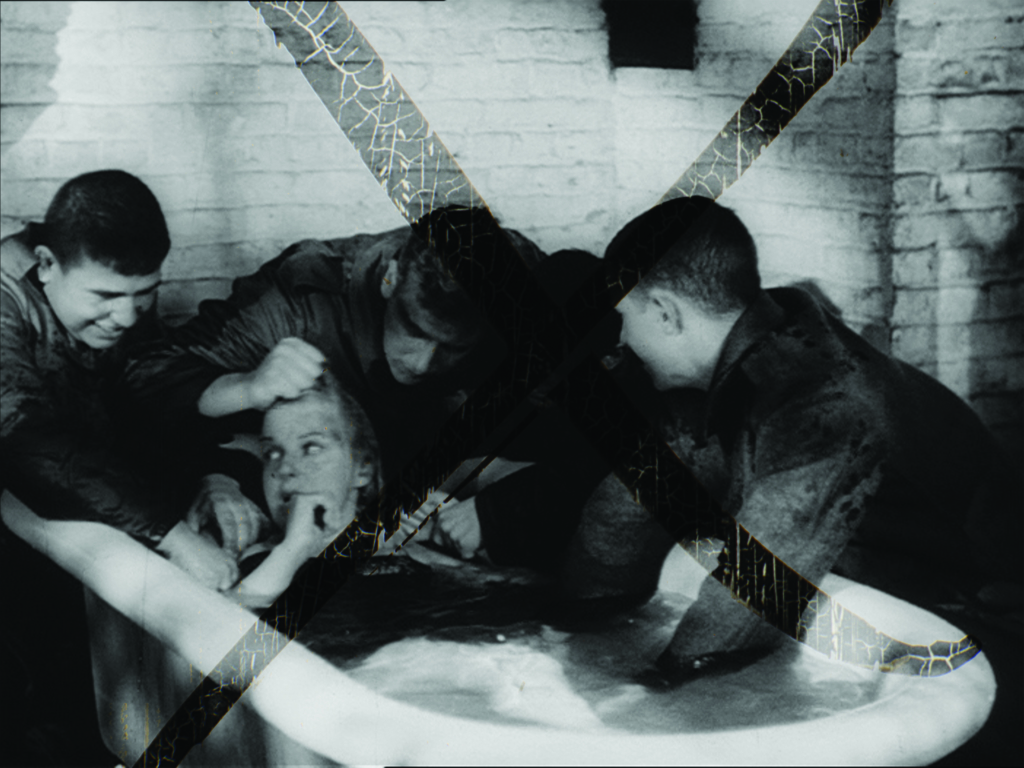
‘It’s interesting – and a bit weird – that Terror Nullius and [Censored] have come out of this country at the same time,’ Braithwaite says. ‘They’re these interesting companions, even though they are so different.’ Both films are archival works, exploring local cinematic history, looking at past images anew. But, from their shared starting point, they head in different directions, arriving at artistic places of wild stylistic contrast. [Censored] is a meditative, personal work, an existential chronicle of the loneliness of the cinema archivist, descending into the darkness of the patriarchal past. Terror Nullius, in contrast, is bold, brash, ridiculous, hilarious – a work of lurid pop art delivered with an audacious swagger.
In conservative film-funding circles, marrying political sentiments to acts of cut-up subversion may make for ‘a very controversial piece of art’, but Terror Nullius, in particular, smacks not of shock value, but of impish delight. The Angeloros speak of their love of ‘the incredible complexity and striking nuance of our national film legacy’, and the way they anarchically, gleefully freewheel through that history doesn’t play as ‘un-Australian’, but rather particularly Australian. The larrikin – that figure that wields irreverence as a form of cultural defiance – is recast as a pair of whipsmart feminists, armed with only a bank of samples and a delightful sense of the absurd. For their part, Soda_Jerk weren’t out to provoke anything but ‘further conversation’, hoping to address the definitive question of contemporary Australia: ‘What steps are needed to begin to repair the deep fissures and atrocities of our past and present in order to move forward as a country?’
Endnotes
| 1 | Luke Buckmaster, ‘Terror Nullius: “Controversial” Australian Film Loses Funders’ Support’, The Guardian, 19 March 2018, <https://www.theguardian.com/film/2018/mar/19/terror-nullius-controversial-australian-film-loses-funders-support>, accessed 20 July 2018. |
|---|---|
| 2 | Arenamedia, [Censored] press kit, 2018, p. 3. |
| 3 | Sari Braithwaite, ‘[Censored] Was Meant to Celebrate Freedom. Instead It Exposes Something Darker’, The Guardian, 31 May 2018, <https://www.theguardian.com/film/2018/may/30/censored-was-meant-to-celebrate-freedom-instead-it-exposes-something-darker>, accessed 20 July 2018. |
| 4 | ‘About’, Soda_Jerk official website, <https://www.sodajerk.com.au/about.php>, accessed 20 July 2018. |
| 5 | Soda_Jerk, quoted in Meg Crawford, ‘How Soda_Jerk Created The Avalanches’ Viral Mega-mashup’, Red Bull website, 16 February 2018, <https://www.redbull.com/au-en/avalanches-mega-video-mash-up-soda-jerk>, accessed 20 July 2018. |
| 6 | Soda_Jerk, quoted in Briony Wright, ‘Soda Jerk Remix Cinema History to Create the Best Movies That Never Existed’, i-D, 10 January 2017, <https://i-d.vice.com/en_au/article/gyqeb9/soda-jerk-remix-cinema-history-to-create-the-best-movies-that-never-existed>, accessed 20 July 2018. |
| 7 | A skit from the Simpsons episode ‘22 Short Films About Springfield’ (Season 7, Episode 21), which has now gained infamy in meme form. |
| 8 | Soda_Jerk, quoted in Bailey Sharp & Ben Juers, ‘“Weaponising Frustration and Despair” – an Interview with Soda_Jerk’, The Lifted Brow, 26 March 2018, <https://www.theliftedbrow.com/liftedbrow/2018/3/25/weaponising-frustration-and-despair-an-interview-with-sodajerk>, accessed 20 July 2018. |
| 9 | See Eunice Oh, ‘Tape of Mel Gibson’s Outburst Hits the Web’, People, 9 July 2010, <https://people.com/celebrity/tape-of-mel-gibsons-outburst-hits-the-web/>, accessed 20 July 2018. |
| 10 | See Max Mason, ‘Tourism Australia Launches $36 Million US Campaign at Super Bowl LII’, Australian Financial Review, 5 February 2018, <https://www.afr.com/business/media-and-marketing/advertising/tourism-australia-launches-36-million-us-campaign-at-super-bowl-lii-20180204-h0to8r>, accessed 23 July 2018. |
| 11 | John Howard, quoted in Shane McLeod, ‘Federal Government Turns Back Asylum Seekers’, transcript, PM, ABC Radio National, 27 August 2001, <http://www.abc.net.au/pm/stories/s353164.htm>, accessed 1 August 2018. |
| 12 | Soda_Jerk also list all their Foley samples – with names like ‘JOL_0187_MetalDestruction_14_HOLDPHONE_5CH’ – providing full transparency for their many compositional ingredients. |
